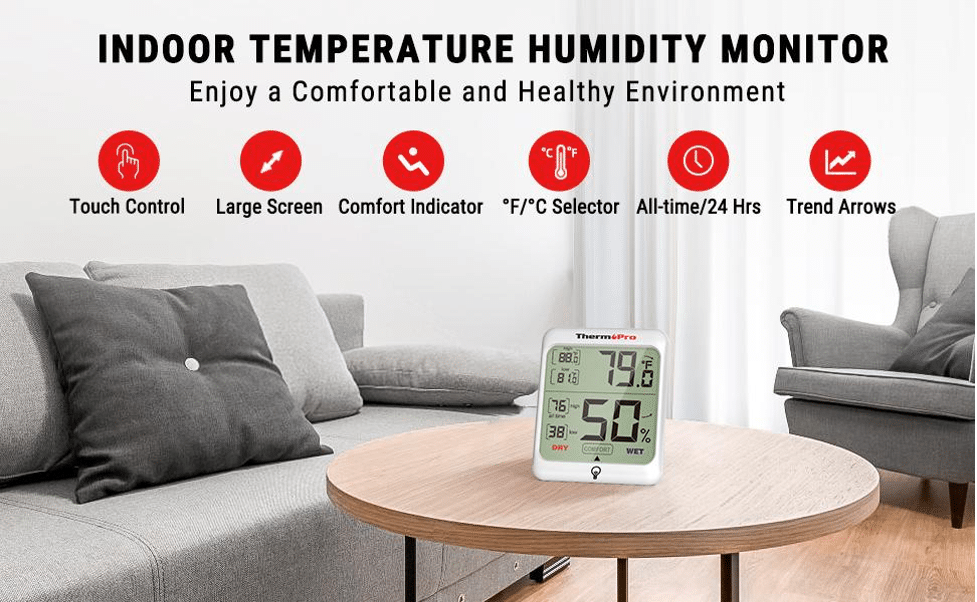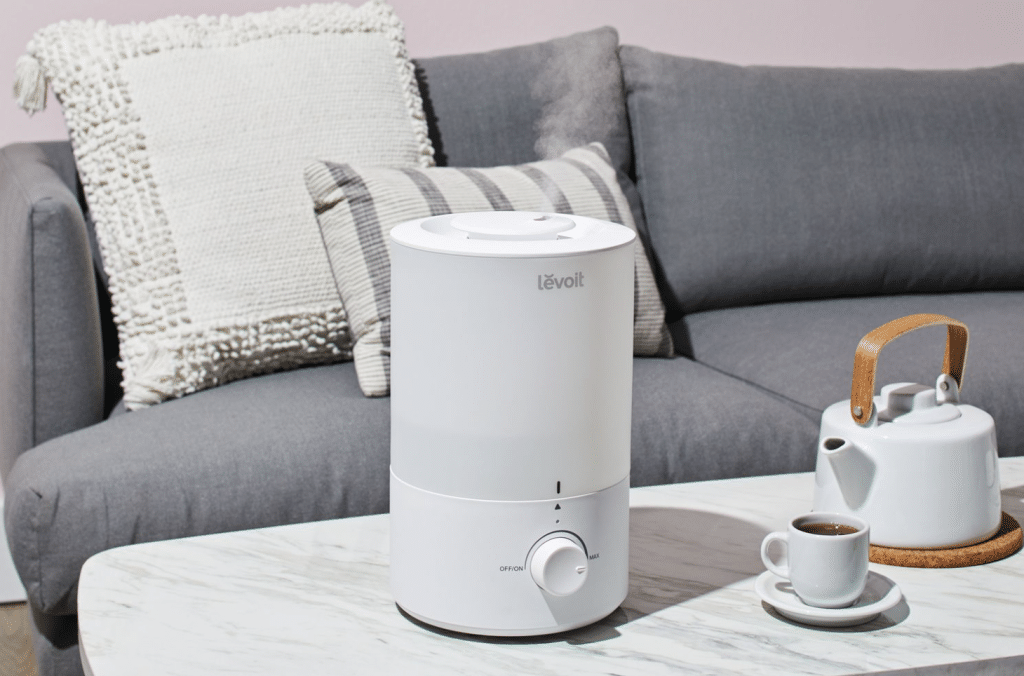If you or a loved one struggles with allergies or asthma, you know how important it is to maintain a clean and healthy indoor environment. While many focus on air purifiers and dust control, one crucial factor often gets overlooked—humidity levels.
Indoor humidity plays a major role in respiratory health. Too much moisture in the air can encourage mold growth, dust mites, and allergens, making breathing more difficult for those with allergies and asthma. On the other hand, air that’s too dry can irritate the respiratory tract, triggering asthma symptoms and making allergy sufferers more sensitive to airborne particles.
So, what’s the ideal indoor humidity level for allergy and asthma sufferers? And how can you keep it in check? In this article, we’ll explore the best humidity range, how it affects your health, and the best way to monitor it using a digital hygrometer like the ThermoPro TP53.
The Impact of Humidity on Allergy and Asthma Symptoms
Humidity plays a significant role in the quality of the air we breathe inside our homes. Both high and low humidity levels can affect allergy and asthma sufferers in various ways. Understanding how humidity impacts your health can empower you to make necessary changes to improve your indoor environment.
High Humidity: The Danger of Mold and Dust Mites
When humidity levels rise above 50% RH (Relative Humidity), it creates an environment that encourages the growth of mold, dust mites, and bacteria. These allergens thrive in moist conditions and can be particularly harmful to those with asthma or allergies. Mold spores and dust mite particles can become airborne and easily trigger coughing, sneezing, wheezing, and difficulty breathing.
Low Humidity: Dry Air and Respiratory Irritation
On the other hand, low humidity, typically below 30% RH, can dry out the respiratory system, leaving the nose and throat irritated. This can lead to symptoms like dry skin, sore throats, nosebleeds, and worsened asthma symptoms, especially for people with already sensitive airways.
Symptoms Triggered by Poor Humidity
Both extremes can lead to uncomfortable and even dangerous symptoms:
- Asthma Symptoms: Wheezing, shortness of breath, chest tightness, and coughing.
- Allergy Symptoms: Sneezing, nasal congestion, itchy eyes, and sinus pressure.
Maintaining a balanced indoor humidity level is vital to reducing these triggers and making breathing easier for allergy and asthma sufferers.
Why It’s Crucial to Monitor and Control Indoor Humidity
Humidity levels within your home affect not only your comfort but also your long-term health. For people with asthma and allergies, maintaining optimal humidity levels can make a significant difference in the severity and frequency of symptoms.
Optimal Humidity Range for Health
The best range for indoor humidity is between 30% and 50% RH. This range reduces the growth of allergens like mold and dust mites, while also preventing your respiratory system from drying out. It’s the sweet spot where the air is neither too dry nor too damp—the ideal zone for both comfort and health.
Benefits of Maintaining Healthy Humidity Levels
By ensuring that humidity levels remain in the optimal range, you’ll experience:
- Reduced Allergen Growth: Proper humidity prevents mold and dust mites from multiplying, helping to keep allergens at bay.
- Improved Breathing: Ideal humidity helps keep your respiratory system moist, reducing irritation and inflammation in your airways.
- Better Sleep: Healthy humidity levels can reduce nighttime symptoms like coughing and sneezing, leading to better quality sleep.
How to Monitor Indoor Humidity Effectively
It’s essential to monitor indoor humidity to ensure it stays within the ideal range. Without the right tools, it’s difficult to know if the air in your home is too dry or too humid. That’s where a hygrometer comes in.
A hygrometer gives you real-time readings of the humidity levels in your home, so you can take action if the air becomes too dry or too humid. Regularly checking humidity levels can help you make adjustments to maintain a consistent environment, particularly in rooms where allergens tend to accumulate, such as bedrooms, bathrooms, and basements.
Key Features to Look for in a Hygrometer
When choosing a hygrometer, it’s important to look for a model that provides:
- Accuracy: Precise humidity and temperature readings ensure you stay within the optimal range.
- Ease of Use: Simple, user-friendly display that’s easy to read at a glance.
- Temperature Readings: Temperature and humidity are often interrelated, and monitoring both is important for maintaining a comfortable, healthy environment.
- Compact Design: A portable device that you can move around to measure humidity in different rooms.
Introducing the ThermoPro TP53 Digital Hygrometer Thermometer
One of the best tools to help you monitor and control your home’s humidity is the ThermoPro TP53 Digital Hygrometer Thermometer. This compact yet highly accurate device offers numerous features that make it a great choice for allergy and asthma sufferers.
The ThermoPro TP53 is a digital hygrometer and thermometer that measures both humidity and temperature. It’s designed to provide real-time readings and is ideal for monitoring indoor air quality to keep humidity levels within the optimal range.

Features of the ThermoPro TP53
- Large LCD Display: The TP53 has a clear, easy-to-read display, showing both humidity and temperature levels at a glance.
- High Accuracy: It measures humidity with an accuracy of ±2% RH from 30% to 80% and ±3% RH below 30%, and temperature with an accuracy of ±2°F, ensuring you get precise readings for maintaining a comfortable indoor environment.
- Memory Function: The device tracks the maximum and minimum humidity and temperature levels, helping you monitor changes throughout the day.
- Compact and Portable: Small enough to move around and place in different rooms, so you can monitor humidity wherever it’s needed.
- Affordable Price: The TP53 offers excellent value, making it a cost-effective solution for improving air quality in your home.
Why It’s Ideal for Allergy & Asthma Sufferers
For allergy and asthma sufferers, maintaining the right humidity level is crucial for minimizing symptoms. The ThermoPro TP53 makes this task easier by providing accurate and continuous readings. By using the TP53 to monitor humidity levels regularly, you can ensure that your home stays in the 30% to 50% RH range, keeping allergens under control and your airways happy.
Practical Tips to Maintain Ideal Humidity Levels
Once you know how to monitor humidity, here are some practical tips to help maintain it within the ideal range:
How to Increase Humidity
- Use a Humidifier: A humidifier adds moisture to the air, making it easier to breathe in dry environments.
- Place Water Bowls Near Heat Sources: A simple trick to increase humidity in a room is placing a bowl of water near a radiator or heater.
How to Decrease Humidity
- Use a Dehumidifier: A dehumidifier removes excess moisture from the air, especially in humid rooms like bathrooms or basements.
- Ventilate Damp Areas: Open windows and use exhaust fans in areas prone to high humidity to keep the air moving.
Regular Maintenance
- Check Humidity Regularly: Use the ThermoPro TP53 to track humidity changes over time and adjust as needed.
- Clean Humidifiers and Dehumidifiers: Regular maintenance ensures these devices work efficiently and prevent bacteria build-up.
Other Considerations for Allergy and Asthma Relief
Humidity is just one aspect of indoor air quality. To further reduce allergens, consider these additional tips:
- Air Purifiers: Using an air purifier can help remove dust, pollen, and other allergens from the air.
- Proper Ventilation: Make sure your home is well-ventilated, particularly in rooms where humidity levels can rise.
- Regular Cleaning: Clean your home frequently to remove dust, mold, and other allergens that can trigger symptoms.
Conclusion
Maintaining optimal indoor humidity levels is an easy but often overlooked way to reduce allergy and asthma symptoms. By using tools like the ThermoPro TP53 Digital Hygrometer Thermometer, you can ensure your home stays comfortable and healthy. With regular monitoring, you can keep your humidity levels in the perfect range to help reduce allergens, improve breathing, and get better sleep.
By following these tips and using the right tools, you can create an environment that’s not only comfortable, but also conducive to better health. Stay informed, stay healthy, and keep your home’s humidity under control!
